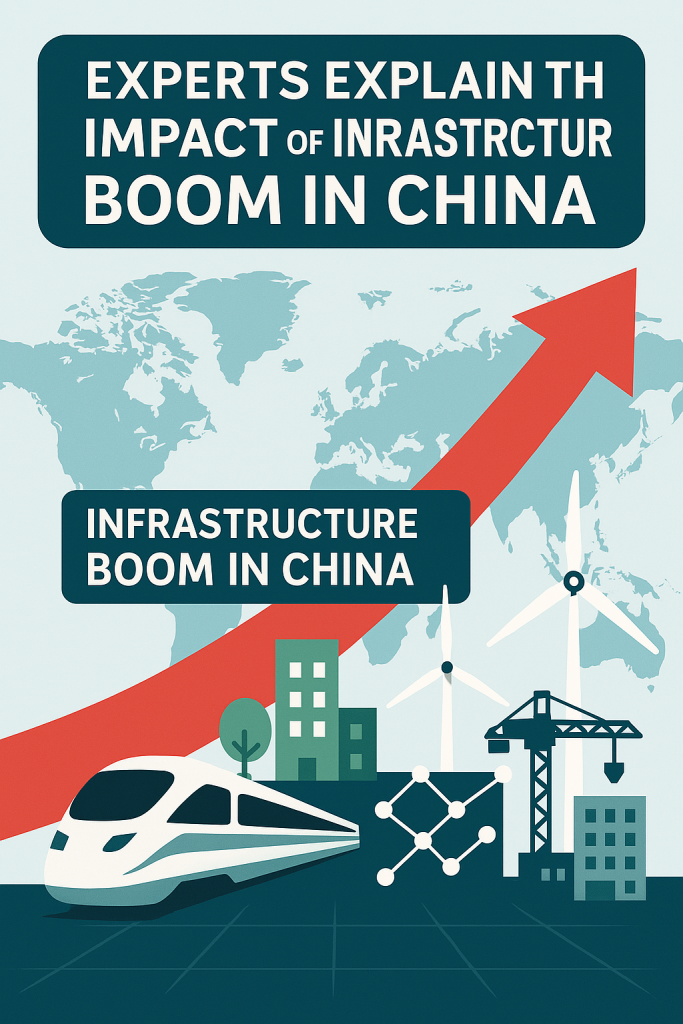🚆 What If China’s Infrastructure Sets the Standard for the World by 2025?
Imagine boarding a high-speed maglev in Western China, powered by hydrogen, arriving in a smart city where highways charge EVs wirelessly, and ports are run entirely by AI. This is not science fiction—it’s the direction China’s infrastructure is heading in 2025.
With trillions of yuan invested and new megaprojects coming online monthly, the infrastructure boom in China is not just transforming domestic life, but reshaping global supply chains, construction norms, and environmental standards.

🧭 Trend Overview: What’s Driving China’s Infrastructure Expansion?
🏗️ 1. New Urbanization Push
The Chinese government has launched a “City Cluster Strategy,” connecting dozens of cities through high-speed rail, underground logistics, and smart highways.
🌱 2. Green Infrastructure Mandates
A new wave of green standards makes solar roads, sponge cities (to handle flooding), and carbon-neutral buildings the norm, not the exception.
🌐 3. Digital + Physical Integration
From 5G-controlled cranes to digital twins of bridges, China is blending infrastructure with real-time data.
🛣️ 4. Belt and Road Revamp 2.0
The Belt and Road Initiative is shifting from ports and railways to include green energy corridors, digital fiber networks, and water management systems.
🧱 5. State-Fintech Partnerships
Infrastructure bonds are increasingly distributed via blockchain, allowing partial ownership and rapid domestic financing.
📊 Real-World Data Snapshots
| Project Category | 2023 Status | 2025 Outlook |
|---|---|---|
| High-speed rail mileage | 42,000 km | 50,000+ km |
| Smart city pilots | 55 cities | 80+ cities |
| Green building % new dev | 36% | 60%+ |
| EV charging stations | 1.8 million | 3.5+ million |
| Infrastructure investment | $1.3 trillion (2023) | $1.7–1.9 trillion (2025) |
🧠 What It Means for Business Leaders
✅ Construction & Engineering Firms
- Prepare for new regulatory environments around smart and green standards.
- Partner with Chinese firms to learn about modular building and rapid deployment techniques.
✅ Logistics & Supply Chain
- China’s smart ports and inland hubs are reducing turnaround time and costs—global companies must adjust distribution models.
✅ Energy Sector
- Solar, hydro, and hydrogen infrastructure will create demand for storage tech, smart grids, and next-gen utility management.
✅ Real Estate Developers
- Urban planning is increasingly centered around transit-oriented developments (TODs). High-rise vertical communities are gaining favor.
📣 Expert Commentary
“China’s infrastructure isn’t just about scale—it’s about coordination and vision. Other countries may build taller skyscrapers, but China builds faster, smarter ecosystems.”
— Dr. Rachel Lee, Urban Futures Institute
“For investors, this is not just about real estate or roads. It’s about AI, fintech, decarbonization, and mobility.”
— Ahmed Patel, Global Infrastructure Equity Group
❓ FAQ: Frequently Asked Questions
1. What is China’s biggest infrastructure priority in 2025?
Integrating green energy, smart cities, and digital logistics into a unified, efficient ecosystem.
2. How is this boom being financed?
Through a mix of central funding, local government debt, international partnerships, and increasingly blockchain-backed investment platforms.
3. Which regions are seeing the most growth?
Western China (Chengdu-Chongqing Economic Circle), Greater Bay Area, and the Yangtze River Delta.
4. Is foreign participation allowed in these projects?
Yes, particularly in green tech, design consulting, and smart system integration, although access is often gated by compliance and local partnerships.
5. How does this affect global competition?
It pushes other countries to accelerate their infrastructure innovation and adopt China-led standards in connectivity, energy, and mobility.
🏁 Final Forecast: More Than Concrete and Steel
The infrastructure boom in China is not just about bridges and buildings—it’s a platform for tech integration, financial experimentation, and green transformation. Business leaders who ignore this trend risk being outpaced in speed, efficiency, and resilience.
If you want a glimpse of the future, don’t just look at Silicon Valley. Look at Chengdu, Shenzhen, and beyond.
